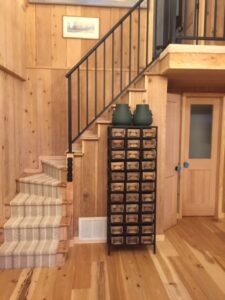 JF sent me a photo of his lovely entry hall. He added a piece he found at a thrift store, a series of antique drawers, actually old wooden boxes. I discovered for him that people used these boxes for molding bricks. The many boxes, or mold, fit in a rough iron shelf armature.
JF sent me a photo of his lovely entry hall. He added a piece he found at a thrift store, a series of antique drawers, actually old wooden boxes. I discovered for him that people used these boxes for molding bricks. The many boxes, or mold, fit in a rough iron shelf armature.
He also sent me a shot of the bottom of one of these molds with a mirror, relief logo style lettering. Each drawer/mold shows different lettering, some in English, some, I best decipher, in Hindi.
When I say mirror relief, I mean that to obtain a pattern of lettering on a mold, one needs to create the lettering in reverse, or mirror image. SO, I deciphered the lettering by holding the photo to a mirror. I find it interesting that both Hindi and English read left to right.
History of Bricks
Another clue to the original use for these little drawers is that JF said they contained sand.
Knowing we see something used for industry, I asked myself, “What’s the history of that industry?” In India, if I assume correctly that some lettering is Hindi, they still practice the traditional brickmaking methods today. JF asked me about the AGE of this collection of mold/drawers. I replied they’re NOT that old. Plastic molds located on the bottoms of the drawers, put them later than 1862, when they invented Parkesine, an early organic plastic. In 1907 we see the invention of synthetic plastic in the development of Bakelite.
Now we know JF’s piece goes back no earlier than the first quarter of the 20th century which indicates the age of what he found. It doesn’t indicate the age of the brick industry. The method of brickmaking hinted on by these little drawer/molds goes back thousands of years, especially as regards ancient India, and I sense residue of that TODAY.
Brickmaking Process
The process starts with clay mined and aged in the air, then mixed with water and, in India, sometimes by hand and foot. A lump of clay is rolled and placed in a mold boxes like JF’s, coated with sand (!!), and left to dry in the rack. Traditionally they made mold box of wood, which indicates JF’s mold boxes, although not old partake in the ancient style of mold making. Once the brick dries the mold is emptied, and dried in the sun, flipping the brick every two days. They call those GREEN BRICKS, then they fire them in the kiln for at least a week. They then sort the bricks, and baked bricks are most desired. The green ones line the outside of the kilns in India.
My great-grandfather Gustav worked as a brick engineer outside of Leipzig, Germany which gives me a special connection with brick manufacture. He invented a type of kiln used in India today. He died at the age of 50 shifting bricks. His son, my “Opa,” also became a great inventor. I visited the spot where Gustav built his kiln in the 1970s, sneaking behind the East German Iron Curtain. Oh, the boldness of youth!
Impact of Bricks
An article published in National Geographic by Pulitzer Prize winning journalist Paul Salopek in 2019 speaks of the dire conditions of brick laborers in present day India. Most of the workers are women, and bricks are very heavy, yet the kilns in India produce 250 billion bricks a year, second only in production to China. The normal workday, according to Salopek, is 12-18 hours a day in shifting brick from molds like JF owns.
The great-granddaughter of a brick mason, who, because of JF’s question, learned the history of brick manufactory goes back well past the Roman Empire, which used baked brick in enormous quantities. It may surprised you to know how necessary brick are and always were. The Empire State Building used ten million bricks in its construction.
I adore JF’s brick mold rack as a piece of sculpture. I’m not sure about its heritage. Still the value is $2,000, as I see people seek after the molds.